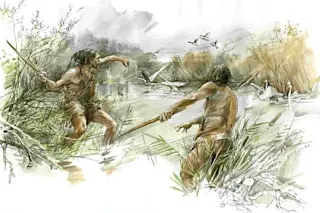Some 300,000 years ago, an early hunter dropped a 30-inch stick in wet mud, and there it stayed through the Last Ice Age, two world wars and the dawning of the internet. The literal stick-in-the-mud remained in excellent condition, considering the amount of time, although it suffered some fungal and root damage.
A new study has unearthed the stick and determines that it was once used as a hunting weapon and thrown like a boomerang.
Read More: Ancient Humans Mapped Out Hunting Device on Boulders
Ancient craftspeople demonstrated great skill in seasoning the stick and sharpening it on each end.
“The woodworking involved multiple steps including cutting and stripping off the bark, carving it into an aerodynamic shape, scraping away more of the surface, seasoning the wood to avoid cracking and warping and sanding it for easier handling,” said archaeologist Dirk Leder in a statement.
The ancient woodworkers (likely Neanderthals ...














